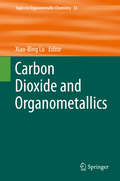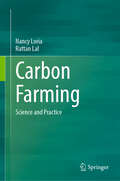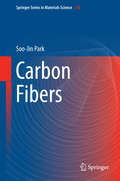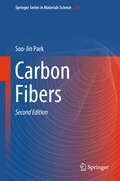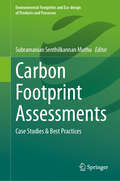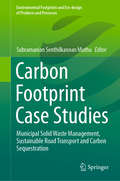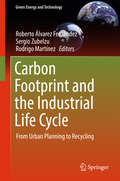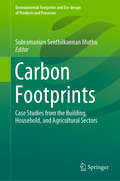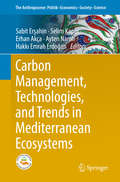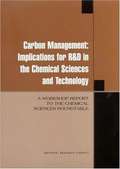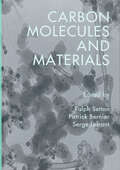- Table View
- List View
Carbon Dioxide and Organometallics (Topics in Organometallic Chemistry #53)
by Xiao-Bing LuThe series Topics in Organometallic Chemistry presents critical overviews of research results in organometallic chemistry. As our understanding of organometallic structure, properties and mechanisms increases, new ways are opened for the design of organometallic compounds and reactions tailored to the needs of such diverse areas as organic synthesis, medical research, biology and materials science. Thus the scope of coverage includes a broad range of topics of pure and applied organometallic chemistry, where new breakthroughs are being achieved that are of significance to a larger scientific audience. The individual volumes of Topics in Organometallic Chemistry are thematic. Review articles are generally invited by the volume editors. All chapters from Topics in Organometallic Chemistry are published OnlineFirst with an individual DOI. In references, Topics in Organometallic Chemistry is abbreviated as Top Organomet Chem and cited as a journal
Carbon Dots: Exploring Carbon at Zero-Dimension
by Ya-Ping SunWritten by the founder of the field of carbon “quantum” dots (carbon dots) and related technology, this book outlines the principles of carbon dots and presents strong evidence for that small carbon nanoparticles and by extension carbon dots represent the nanoscale carbon allotrope at zero-dimension. Historical accounts of the inception and evolution of the carbon dots field are provided. Experimental approaches and techniques for the dot synthesis and some related major issues are discussed in detail. The photoexcited state properties, especially the bright and colorful photoluminescence emissions, and photoinduced redox characteristics of carbon dots are presented, and so are their advantages over semiconductor quantum dots as well as fullerenes. Carbon dots are also compared with “graphene quantum dots”, for which a unified mechanistic understanding is proposed. Finally, a broad range of applications of carbon dots and their derived hybrid nanostructures in biomedical, renewable energy, food and environmental safety, and other technologies are highlighted. The book concludes with a discussion on the excellent potential and opportunities for further research and development.
Carbon Emission Calculation Methods for Highway Tunnel Construction
by Jianfeng Xu Chun GuoThis book introduces the research background and significance of carbon emissions in the tunnel industry and systematically reviewed the research progresses of carbon emission researches for tunnels, LCA (life cycle assessment) research framework, and uncertainty research progress. The authors propose a novel modular carbon emission calculation method for highway tunnel construction and expounds on the modular LCA system boundary theory of tunnel construction. This method does not require abundant knowledge of LCA modeling, which is convenient for general engineering and technical personnel to calculate the carbon emission level of tunnel construction. The calculation formulas for input and carbon emissions of each module are provided. It also analyzes the parameter uncertainty, model uncertainty, and scenario uncertainty of the carbon emissions from tunnel construction by the Monte Carlo method. Further, this book proposes the fitting model of carbon emissions of unit engineering quantity in tunnel construction, which benefits to simplify the calculation of carbon emissions.This book is mainly aimed at engineering and technical personnel in the construction industry, especially tunnel and underground engineering, including tunnel design engineers; tunnel construction engineers, experts, and scholars; tunnel owners; management departments.
Carbon Emissions in China (Springer Theses)
by Zhu LiuThis study analyzes the spatial-temporal pattern and processes of China's energy-related carbon emissions. Based on extensive quantitative analysis, it outlines the character and trajectory of China's energy-related carbon emissions during the period 1995-2010, examining the distribution pattern of China's carbon emissions from regional and sectoral perspectives and revealing the driving factors of China's soaring emission increase. Further, the book investigates the supply chain carbon emissions (the carbon footprints) of China's industrial sectors. Population growth, the fossil energy supply, and anthropogenic climate change are the most serious challenges currently facing humankind. China is the world's largest developing country, top primary energy consumer and carbon emitter. Achieving both economic growth and environmental conservation is the country's twofold challenge. Understanding the status, features and driving forces of China's energy-related carbon emissions is a critical aspect of attaining global sustainability. This work, for the first time, presents both key findings on and a systematic evaluation of China's carbon emissions from energy consumption. The results have important implications for global carbon budgets and burden-sharing with regard to climate change mitigation. The book will be of great interest to readers around the world, as it addresses a topic of truly global significance.
Carbon Farming: Science and Practice
by Rattan Lal Nancy LoriaIn a world grappling with the pressing challenges of climate change and sustainable food production, "Carbon Farming" emerges as a transformative concept with far-reaching implications. Carbon farming, a cornerstone of sustainable agriculture dedicated to actively sequestering carbon from the atmosphere and securely storing it within vegetation and soil, also creates another income stream for farmers and ranchers. It's more than just an ecological solution; it's a holistic approach that integrates social, environmental, and economic development. It is also the foundation stone for achieving Sustainable Development Goals of the Agenda 2030 of the United Nations. The book confronts a series of captivating questions that arise when focusing on increasing soil carbon through Sustainable Agricultural Practices. Through a series of meticulously crafted chapters, the book unravels the potential impact of carbon farming on soil health, the carbon cycle, and the broader global environment. The book navigates through a diverse array of carbon farming techniques, from conservation and regenerative agriculture to agroecology, agroforestry and composting. It provides practical insights, supported by compelling case studies, showcasing successful implementations of these practices in real-world agricultural contexts. Readers are equipped with a toolkit of effective carbon farming strategies, offering a valuable resource for those seeking to adopt sustainable and climate-resilient farming practices. This book is not just a resource; it's a call to action. It's an invitation to be part of a movement that has the power to transform agriculture and safeguard our planet for generations to come. Join us in the journey of understanding, implementing, and advocating for carbon farming—a practice that holds the key to a more sustainable and resilient future.
Carbon Fibers (Springer Series in Materials Science #210)
by Soo-Jin ParkThis book contains eight chapters that discuss the manufacturing methods, surface treatment, composite interfaces, microstructure-property relationships with underlying fundamental physical and mechanical principles, and applications of carbon fibers and their composites. Recently, carbon-based materials have received much attention for their many potential applications. The carbon fibers are very strong, stiff, and lightweight, enabling the carbon materials to deliver improved performance in several applications such as aerospace, sports, automotive, wind energy, oil and gas, infrastructure, defense, and semiconductors. However, the use of carbon fibers in cost-sensitive, high-volume industrial applications is limited because of their relatively high costs. However, its production is expected to increase because of its widespread use in high-volume industrial applications; therefore, the methods used for manufacturing carbon fibers and carbon-fiber-reinforced composites and their structures and characteristics need to be investigated.
Carbon Fibers (Springer Series in Materials Science #210)
by Soo-Jin ParkThe updated and expanded second edition of this book explores the physical and mechanical properties of carbon fibers and their composites, their manufacture and processing, and their current and emerging applications. Over 10 chapters, the book describes manufacturing methods, surface treatment, composite interfaces, and microstructure-property relationships with underlying fundamental physical and mechanical principles. It discusses the application of carbon materials in delivering improved performance across a diverse range of fields including sports, wind energy, oil and gas, infrastructure, defence, and the aerospace, automotive and semiconductor industries.This new edition introduces chapters related to the manufacturing of carbon/carbon composites (C/C composites), antioxidation characteristics of C/C composites, and their applications. Furthermore, it addresses the effect of graphene and carbon nanotubes on the physical and chemical properties of carbon fibers. A final chapter looks at the emerging and future prospects for carbon fiber technology.
Carbon Fibers and Their Composites (Materials Engineering)
by Peter MorganMost literature pertaining to carbon fibers is of a theoretical nature. Carbon Fibers and their Composites offers a comprehensive look at the specific manufacturing of carbon fibers and graphite fibers into the growing surge of diverse applications that include flameproof materials, protective coatings, biomedical and prosthetics application
Carbon Fluorides: Properties, Preparation, and Applications
by Wei FengThis book offers a comprehensive perspective on carbon fluorides, covering detailed descriptions of the structure, properties, preparation, and applications of carbon fluorides, from basic knowledge to the latest research developments. It provides readers with a clear and in-depth analysis of carbon fluorides. This book first describes the structural properties of carbon fluorides, such as the formation of different types of C-F bonds, F/C ratio, and the impact of F atom distribution on material properties. The introduction of F atoms results in unique properties of carbon fluorides in terms of optics, electronics, thermal properties, and mechanical strength, distinguishing them from carbon materials. This book also introduces various carbon fluoride materials prepared from various carbon material precursors currently under research, such as fluorinated graphene, fluorinated carbon nanotubes, fluorinated graphite, and fluorinated fullerenes. The detailed description of the research and applications of carbon fluorides in batteries and other areas is provided. This book is suitable for professionals and academic researchers and also serves as a self-study reference for beginners interested in this field. The author of this book has over a decade of experience and expertise in carbon fluorides research, providing readers with a rich and comprehensive book in this field.
Carbon Footprint Assessments: Case Studies & Best Practices (Environmental Footprints and Eco-design of Products and Processes)
by Subramanian Senthilkannan MuthuClimate change and its impacts are well known, and it is not hard to see the effects of climate change vulnerability to daily lives in many parts of the world. The need to assess and reduce carbon footprint is not specific to any industrial sector; rather it is an imperative to all aspects of industry. To that end, this book offers case studies detailing methods and best practices toward the assessment of carbon footprint in various industrial spaces. The chapters here highlight the urgency of measuring and alleviating the climate change impacts for various industrial sectors, and together they offer an overview of the current state of research on carbon footprint assessment in different industries ranging from textiles, agriculture, logistics, wine production, and more.
Carbon Footprint Case Studies: Municipal Solid Waste Management, Sustainable Road Transport and Carbon Sequestration (Environmental Footprints and Eco-design of Products and Processes)
by Subramanian Senthilkannan MuthuGlobal warming and its effects are felt and understood by almost every one across the globe now. Carbon footprint calculation and mitigation in different industrial sectors is the need of the hour. There are numerous industrial sectors, whose carbon footprints need to be calculated and the ways to mitigate the greenhouse gas emissions from those sectors need to be started with immediate effect. This book highlights case studies involving the carbon footprints of municipal solid waste, sustainable road transport and Carbon footprint accounting of sources and sinks by studying carbon sequestration of Karnataka, a state in India.
Carbon Footprint and the Industrial Life Cycle: From Urban Planning to Recycling (Green Energy and Technology)
by Sergio Zubelzu Roberto Álvarez Fernández Rodrigo MartínezThis book analyzes the relationship between large-scale industrial activity and the carbon footprint, and provides a theoretical framework and tools to calculate the carbon footprint of industrial activities at every stage of their life cycles, including urban-planning master plans, recycling activities, project and building stages as well as managing and manufacturing. Discussing the main preventative and corrective measures that can be utilized, it includes case studies, reports on technological developments and examples of successful policies to provide inspiration to readers. This book collects the contributions of authors from four continents, in order to analyze from as many as possible points of view and using many different approaches, the problem of sustainability in today's globalized world.
Carbon Footprints of Manufacturing and Transportation Industries (Environmental Footprints and Eco-design of Products and Processes)
by Subramanian Senthilkannan MuthuThis book presents carbon footprint calculation and mitigation in the manufacturing and transportation sectors. Warning effects of global warming from every sector is of phenomenal importance at this moment and sector wise assessment and remediation are the key factors to mitigate the vulnerable green house gas emissions. This volume with its six chapters deals with the carbon footprint of manufacturing and transportation sectors.
Carbon Footprints: Case Studies from the Building, Household, and Agricultural Sectors (Environmental Footprints and Eco-design of Products and Processes)
by Subramanian Senthilkannan MuthuThis book addresses carbon footprint calculation and mitigation in various industrial sectors. There are numerous sectors whose carbon footprints need to be calculated, and effective ways to mitigate the greenhouse-gas emissions from these sectors need to be found. This book highlights the carbon sequestration potential of the Western Ghats ecosystems, the carbon footprint of Spanish households and residential buildings, and agricultural products in Canada; it also includes a case study on urban carbon footprints.
Carbon Footprints: Case Studies from the Energy and Transport Sectors (Environmental Footprints and Eco-design of Products and Processes)
by Subramanian Senthilkannan MuthuThis book presents revealing case studies on carbon footprint calculation and mitigation in various industrial sectors. There are numerous sectors whose carbon footprints need to be calculated, and effective ways to mitigate the greenhouse-gas emissions from these sectors need to be found. Using representative case studies, this book highlights the carbon footprint of national power generation systems, crude glycerol production plants and the Brazilian highway network system, as well as the integration of renewable energy sources in expansion planning, so as to promote and implement power system decarbonization.
Carbon Labeling Practice: From the Perspective of Stakeholder’s Interaction
by Rui Zhao Yong GengThis book focuses on the behavioral interactions among possible stakeholders in carbon labeling practice, brings the attentions of stakeholders’ interests to explore the opportunities, and challenges related to carbon labeling practice, thus to provide insight into low-carbon consumption and production. It is essential reading for students, researchers, and policy makers as well as those with a wider interest in environmental science and sustainable development.
Carbon Management for Promoting Local Livelihood in the Hindu Kush Himalayan (HKH) Region
by Victor R. Squires Zhanhuan Shang A. Allan Degen Muhammad Khalid RafiqThis book contributes to our understanding of linkages between carbon management and local livelihoods by taking stock of the existing evidence and drawing on field experiences in the Hindu Kush Himalayan (HKH) region, an area that provides fresh water to more than 2 billion people and supports the world’s largest population of pastoralists and millions of livestock. This edited volume addresses two main questions: 1. Does carbon management offer livelihood opportunities or present risks, and what are they? 2. Do the attributes of carbon financing alter the nature of livelihood opportunities and risks? Chapters analyze the most pressing deficiencies in understanding carbon storage in both soils and in above ground biomass, and the related social and economic challenges associated with carbon sequestration projects. Chapters deliver insights to both academics from diverse disciplines (natural sciences, social sciences and engineering) and to policy makers.
Carbon Management for a Sustainable Environment
by Shelley W. ZhouThis textbook presents students with a systematic approach for the quantification and management of greenhouse gas emissions (GHG) and provides best practices for optimal carbon management and quantification. The book begins with an overview of climate change basics and goes on to discuss carbon footprint measurements, carbon management concepts, and concludes by presenting carbon reduction solutions with applications for green buildings, smart transportation, waste management, and carbon trading and offsetting. The author provides practical examples and carbon management models that support innovative reduction solutions and presents a roadmap for the implementation and development of carbon management strategies, making it a useful resource for both upper undergraduate and graduate students as well as practitioners seeking a comprehensive framework to conduct carbon management.
Carbon Management in Tropical and Sub-Tropical Terrestrial Systems
by Probir K. Ghosh Sanat Kumar Mahanta Debashis Mandal Biswapati Mandal Srinivasan RamakrishnanSoil organic carbon (SOC), a key component of the global carbon (C) pool, plays an important role in C cycling, regulating climate, water supplies and biodiversity, and therefore in providing the ecosystem services that are essential to human well-being. Most agricultural soils in temperate regions have now lost as much as 60% of their SOC, and as much as 75% in tropical regions, due to conversion from natural ecosystems to agricultural uses and mainly due to continuous soil degradation. Sequestering C can help to offset C emissions from fossil fuel combustion and other C-emitting activities, while also enhancing soil quality and long-term agronomic productivity. However, developing effective policies for creating terrestrial C sinks is a serious challenge in tropical and subtropical soils, due to the high average annual temperatures in these regions. It can be accomplished by implementing improved land management practices that add substantial amounts of biomass to soil, cause minimal soil disturbance, conserve soil and water, improve soil structure, and enhance soil fauna activity. Continuous no-till crop production is arguably the best example. These soils need technically sound and economically feasible strategies to sustainably enhance their SOC pools. Hence, this book provides comprehensive information on SOC and its management in different land-use systems, with a focus on preserving soils and their ecosystem services. The only book of its kind, it offers a valuable asset for students, researchers, policymakers and other stakeholders involved in the sustainable development and management of natural resources at the global level.
Carbon Management, Technologies, and Trends in Mediterranean Ecosystems (The Anthropocene: Politik—Economics—Society—Science #15)
by Sabit Erşahin Selim Kapur Erhan Akça Ayten Namlı Hakkı Emrah ErdoğanThis book pursues a unique approach, investigating both the ecological and socio-economic aspects of carbon management in Mediterranean ecosystems. All chapters are based on papers originally presented at the 1st Istanbul Carbon Summit, held at Istanbul Technical University, 2-4 April, 2014, and revised following a peer-review process. The book addresses the summit's three main themes - carbon management, carbon technologies, and carbon trends - while also offering chapters on the economic aspects of carbon management and the ecological aspects of the carbon cycle. The chapters on economic aspects analyze the carbon trade and its institutional, political, and legislative structures in different Mediterranean nations, while those on ecological aspects review the discourse on and analysis of the related ecological factors and their feedback due to governance processes.
Carbon Management: A WORKSHOP REPORT TO THE CHEMICAL SCIENCES ROUNDTABLE
by Chemical Sciences RoundtableA report on Carbon Management
Carbon Markets: An International Business Guide (Environmental Market Insights)
by Nick Eyre Arnaud Brohé Nicholas HowarthWinner of the Choice Outstanding Academic Titles of 2010 award. This book is a comprehensive and accessible guide to understanding the opportunities offered by regulated and voluntary carbon markets for tackling climate change. Coverage includes: - An overview of the problem of climate change, with a concise review of the most recent scientific evidence in different fields - A highly accessible introduction to the economic theory and different constitutive elements of a carbon allowances market - Explanation of the Kyoto Protocol and its flexibility mechanisms - Explanation of how the EU Emissions Trading Scheme works in practice - Ongoing developments in regulated carbon markets in the US - Up-to-the-minute coverage of regulated carbon markets in Australia - Developments in New Zealand and Japan - Carbon offsetting and voluntary carbon markets. Combining theoretical aspects with practical applications, this book is for business leaders, financiers, carbon traders, lawyers, bankers, researchers, policy makers and anyone interested in market mechanisms to mitigate climate change. The carbon emissions resulting from the production of this book have been calculated, reduced and offset to render the bookcarbon neutral.
Carbon Markets: Microstructure, Pricing And Policy
by Gbenga Ibikunle Andros GregoriouThis book explores the microstructure of carbon markets and the pricing of carbon financial instruments generally. It provides a critical microstructure analysis of the EU Emissions Trading Scheme (EU-ETS), and also examines the theoretical and related market design issues affecting emissions trading schemes. Individual chapters analyse how intraday pricing evolves in carbon markets, the price impact of block trades in carbon financial instruments and their determinants, short and long-term liquidity effects in carbon markets, and the links between carbon market liquidity and efficiency. The aforementioned issues are explored using case studies of two major trading platforms operating within the EU-ETS. The book concludes by focusing on future policy and regulatory challenges in carbon markets, especially with respect to addressing pricing volatility challenges.
Carbon Membrane Technology: Fundamentals and Applications
by Xuezhong He Izumi KumakiriCarbon membranes have great advantages of strong mechanical strength and high chemical stabilities, as well as high separation performance to reach the industrial attractive region. Further improvement on membrane performance can potentially offset the relatively high production cost compared to polymeric membranes. However, there are still some challenges related to fabrication of asymmetric carbon membranes, the controlling of structure and pore-size and module up-scaling for commercial application. The aim of this book is to provide the fundamentals on carbon membrane materials for the young researchers and engineers to develop frontier membrane materials for energy efficient separation process. This book describes the status and perspectives of both self-supported and supported carbon membranes from fundamentals to applications. The key steps on the development of high performance carbon membranes including precursor selection, tuning carbon membrane structure and regeneration are discussed. In the end, different potential applications both in gas and liquids separation are well described, and the future directions for carbon membrane development were pointed out. To this end, membrane science and engineering are set to play crucial roles as enabling technologies to provide energy efficient and cost-effective future solutions for energy and environment related processes. Based on this approach the research projects which are trying to find attractive carbon materials in our days are many. The published papers, per year, in the topic of carbon membranes, especially for biogas upgrading, natural gas sweetening and hydrogen purification, are numerous with very high impact. However, only few are the books which include relevant to the topic of carbon membrane technology. This book offers the condensed and interdisciplinary knowledge on carbon membranes, and provides the opportunity to the scientists who are working in the field of carbon membrane technology for gas and liquid separations to present, share, and discuss their contributions within the membrane community.
Carbon Molecules and Materials
by Patrick Bernier Serge Lefrant Ralph SettonThe unexpected recent discovery and synthesis of a new form of elemental carbon has initiated an abundance of papers on all aspects of the chemistry and physics of the carbon family. Carbon Molecules and Materials takes stock of the current understanding of these various solid forms and, more particularly, of the diamond, graphite and fullerenes. A
